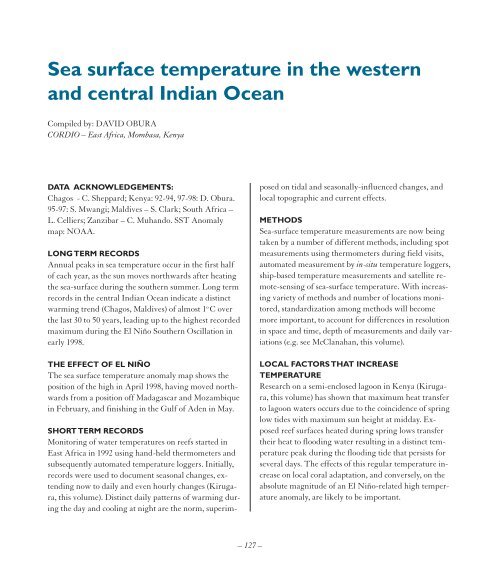Create successful ePaper yourself
Turn your PDF publications into a flip-book with our unique Google optimized e-Paper software.
Sea surface temperature in the western<br />
and central Indian Ocean<br />
Compiled by: DAVID OBURA<br />
<strong>CORDIO</strong> – East Africa, Mombasa, Kenya<br />
DATA ACKNOWLEDGEMENTS:<br />
Chagos - C. Sheppard; Kenya: 92-94, 97-98: D. Obura.<br />
95-97: S. Mwangi; Maldives – S. Clark; South Africa –<br />
L. Celliers; Zanzibar – C. Muhando. SST Anomaly<br />
map: NOAA.<br />
LONG TERM RECORDS<br />
Annual peaks in sea temperature occur in the first half<br />
of each year, as the sun moves northwards after heating<br />
the sea-surface during the southern summer. Long term<br />
records in the central Indian Ocean indicate a distinct<br />
warming trend (Chagos, Maldives) of almost 1 o C over<br />
the last 30 to 50 years, leading up to the highest recorded<br />
maximum during the El Niño Southern Oscillation in<br />
early 1998.<br />
THE EFFECT OF EL NIÑO<br />
The sea surface temperature anomaly map shows the<br />
position of the high in April 1998, having moved northwards<br />
from a position off Madagascar and Mozambique<br />
in February, and finishing in the Gulf of Aden in May.<br />
SHORT TERM RECORDS<br />
Monitoring of water temperatures on reefs started in<br />
East Africa in 1992 using hand-held thermometers and<br />
subsequently automated temperature loggers. Initially,<br />
records were used to document seasonal changes, extending<br />
now to daily and even hourly changes (Kirugara,<br />
this volume). Distinct daily patterns of warming during<br />
the day and cooling at night are the norm, superimposed<br />
on tidal and seasonally-influenced changes, and<br />
local topographic and current effects.<br />
METHODS<br />
Sea-surface temperature measurements are now being<br />
taken by a number of different methods, including spot<br />
measurements using thermometers during field visits,<br />
automated measurement by in-situ temperature loggers,<br />
ship-based temperature measurements and satellite remote-sensing<br />
of sea-surface temperature. With increasing<br />
variety of methods and number of locations monitored,<br />
standardization among methods will become<br />
more important, to account for differences in resolution<br />
in space and time, depth of measurements and daily variations<br />
(e.g. see McClanahan, this volume).<br />
LOCAL FACTORS THAT INCREASE<br />
TEMPERATURE<br />
Research on a semi-enclosed lagoon in Kenya (Kirugara,<br />
this volume) has shown that maximum heat transfer<br />
to lagoon waters occurs due to the coincidence of spring<br />
low tides with maximum sun height at midday. Exposed<br />
reef surfaces heated during spring lows transfer<br />
their heat to flooding water resulting in a distinct temperature<br />
peak during the flooding tide that persists for<br />
several days. The effects of this regular temperature increase<br />
on local coral adaptation, and conversely, on the<br />
absolute magnitude of an El Niño-related high temperature<br />
anomaly, are likely to be important.<br />
– 127 –


















